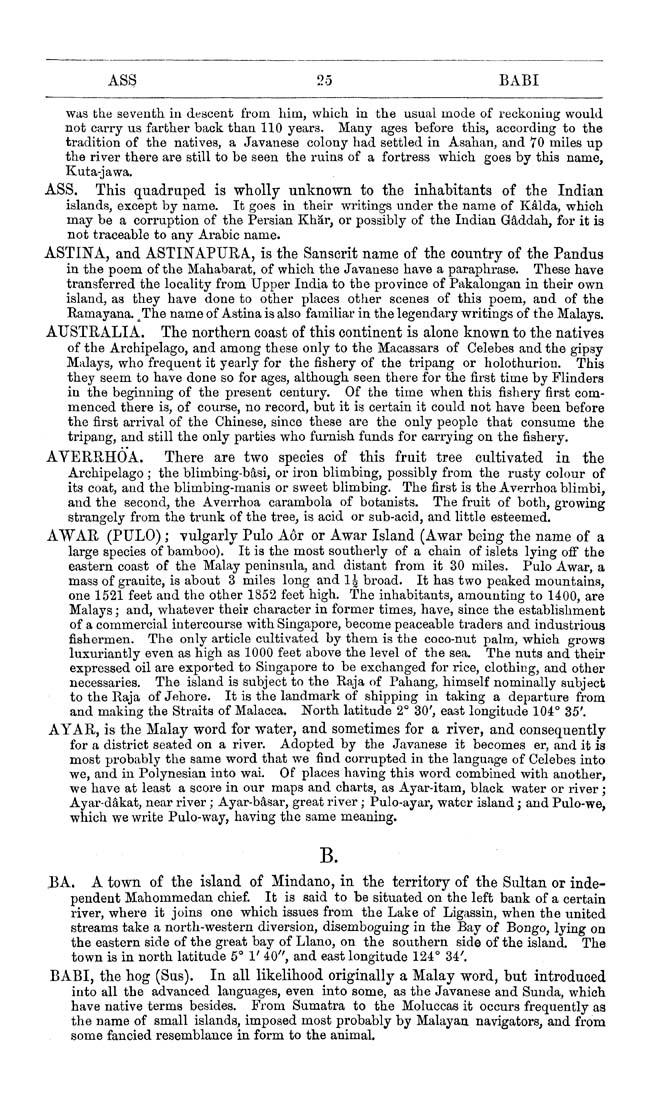ASS 25 BABI
was the seventh in descent from him, which in the usual mode of reckoning would
not carry us farther back than 110 years. Many ages before this, according to the
tradition of the natives, a Javanese colony had settled in Asahan, and 70 miles up
the river there are still to be seen the ruins of a fortress which goes by this name,
Kuta-jawa.
ASS. This quadruped is wholly unknown to the inhabitants of the Indian
islands, except by name. It goes in their writings under the name of Kalda, which
may be a corruption of the Persian Khar, or possibly of the Indian G^ddah, for it is
not traceable to any Arabic name.
ASTINA, and ASTINAPURA, is the Sanscrit name of the country of the Pandus
in the poem of the Mahabarat, of which the Javanese have a paraphrase. These have
transferred the locality from Upper India to the province of Pakalongan in their own
island, as they have done to other places other scenes of this poem, and of the
Ramayana. ^The name of Astina is also familiar in the legendary writings of the Malays.
AUSTRALIA. The northern coast of this continent is alone known to the natives
of the Archipelago, and among these only to the Macassars of Celebes and the gipsy
Malays, who frequent it yearly for the fishery of the tripang or holothurion. This
they seem to have done so for ages, although seen there for the first time by Flinders
in the beginning of the present century. Of the time when this fishery first com¬
menced there is, of course, no record, but it is certain it could not have been before
the first arrival of the Chinese, since these are the only people that consume the
tripang, and still the only parties who furnish funds for carrying on the fishery.
AYERRHOA. There are two species of this fruit tree cultivated in the
Archipelago ; the blimbing-beisi, or iron blimbing, possibly from the rusty colour of
its coat, and the blimbing-manis or sweet blimbing. The first is the Averrhoa blimbi,
and the second, the Averrhoa carambola of botanists. The fruit of both, growing
strangely from the trunk of the tree, is acid or sub-acid, and little esteemed.
AWAR (PULO); vulgarly Pulo Aor or Awar Island (Awar being the name of a
large species of bamboo). It is the most southerly of a chain of islets lying off the
eastern coast of the Malay peninsula, and distant from it 30 miles. Pulo Awar, a
mass of granite, is about 3 miles long and 1^ broad. It has two peaked mountains,
one 1521 feet and the other 1852 feet high. The inhabitants, amounting to 1400, are
Malays; and, whatever their character in former times, have, since the establishment
of a commercial intercourse with Singapore, become peaceable traders and industrious
fishermen. The only article cultivated by them is the coco-nut palm, which grows
luxuriantly even as high as 1000 feet above the level of the sea. The nuts and their
expressed oil are exported to Singapore to be exchanged for rice, clothing, and other
necessaries. The island is subject to the Raja of Pahang, himself nominally subject
to the Raja of Jehore. It is the landmark of shipping in taking a departure from
and making the Straits of Malacca. North latitude 2° 30', east longitude 104° 35'.
AYAR, is the Malay word for water, and sometimes for a river, and consequently
for a district seated on a river. Adopted by the Javanese it becomes er, and it is
most probably the same word that we find corrupted in the language of Celebes into
we, and in Polynesian into wai. Of places having this word combined with another,
we have at least a score in our maps and charts, as Ayar-itam, black water or river;
Ayar-d^kat, near river ; Ayar-b^sar, great river ; Pulo-ayar, water island; and Pulo-we,
which we write Pulo-way, having the same meaning.
B.
13A. A town of the island of Mindano, in the territory of the Sultan or inde¬
pendent Mahommedan chief. It is said to be situated on the left bank of a certain
river, where it joins one which issues from the Lake of Ligassin, when the united
streams take a north-western diversion, disemboguing in the Bay of Bongo, lying on
the eastern side of the great bay of Llano, on the southern side of the island. The
town is in north latitude 5° 1' 40", and east longitude 124° 34^
BABI, the hog (Sus). In all likelihood originally a Malay word, but introduced
into all the advanced languages, even into some, as the Javanese and Sunda, which
have native terms besides. From Sumatra to the Moluccas it occurs frequently as
the name of small islands, imposed most probably by Malayan navigators, and from
some fancied resemblance in form to the animah
|








